The names of the TVs in the USSR list. The first color TV. What was the name of the first Soviet color TV?
Regular television broadcasting in Russia (USSR) began on March 10, 1939.The first Soviet television (prefix - the television did not have its own loudspeaker and was connected to a broadcasting receiver) was set up at the Leningrad Kominternsky plant (now the Kozitsky plant) in Leningrad, using the Nipkow disk system.
It was a brand B-2, with a screen size of 3x4 cm. In 1933-1936. The plant produced about 3 thousand of these TVs.
B-2. 1932.
Mechanical tv"Pioneer TM-3" .1934 g
In 1938, the Comintern plant produced the TK-1 TVs, it was a complex model with 33 radio tubes and was manufactured under an American license and using their documentation. By the end of the year, about 200 television sets were produced. By the beginning of World War II, their park was up to 2,000. Approximately the same was made TVs model VRK (All-Union Radio Committee).
TC-1. 1938
Table tv"17TN-1" 1939
Work on the creation of a simplified television receiver, designed for the mass consumer, was carried out at another Leningrad enterprise, the Radist plant (it was him who was led by leading experts from VNIIT and from the Kozitsky plant). And in 1940, the 17TN-1 serial desktop television with a screen diameter of 17 cm was created in the Radista's laboratories. Before the war, the plant managed to produce no more than 2 thousand TVs of this brand.
The first floor TV "Moskvich". 1946
Televisions "Moskvich" with radio
Before the war, the Aleksandrovsky Plant produced the first Soviet television, which was superior in quality to American RCA - ATP-1. But the KVN-49 is considered to be the first Soviet TV to be truly, even Stalin watched it. The first TVs cost more than 900 rubles (several monthly salaries).
TV KVN-49 TV KVN-49 with lens with distilled water
TV KVN-49 TVLeningrad T-1 1947
Teleradiola "Belarus"

The Moscow Television Factory (now Rubin), was established in 1951, and released the first televisions North
in 1953, the Alexander Record radio plant began producing television sets in 1957. Since the post-war park of televisions in the USSR was small, in 1951-55. an attempt was made to create a systemconsistent color television
(having some advantages, but incompatible with black-and-white, and therefore previously rejected in America). A standard of 525 lines was selected at 25 frames (50 fields) per second, a disk with color filters rotated in front of the tube in the transmitting chamber, the same disk rotated synchronously in front of the picture tube screen on the TV (with red light filters, red parts of the image were transmitted with blue - blue). Experimental broadcasting was conducted withExperimental station of color television
, OCTT-1. At the Leningrad plant them. Kozitsky was released several hundred color TV "Rainbow" with a 18 cm-diameter kinescope (with increased brightness - to compensate for the loss of light in the filters).
in 1957 the number of television sets in the USSR exceeded one million.
Color TV "Rainbow"Color TV "Minsk - 1"
Let's go ahead and look at the first projection TVs made in the USSR. They were not in free sale, they were made in small batches by request of organizations with1951 of the year. Before you are the later models "Moscow "and"Topaz " (1957-1961)
These "nightstands", with dimensions of about 1x0.5x0.5 meters, collected in wooden cases, weighed about 70 kg and were designed for simultaneous viewing by 25-30 spectators. In addition to receiving television programs, they could receive radio stations or twist records, had a non-weak acoustic system (up to 6 speakers) and a wired remote control.
To ensure maximum brightness of the image, the projectors were completed with an aluminum reflecting screen in a frame with dimensions: 1045x1345x70 mm (1300x1060x130 mm) with two folding supports, which was installed 2.5 meters from the TV and weighed about 30 kg. The installation uses a kinescope6ЛК1 (Б) with an optical-mechanical system that allows you to project the image on the screen in quality, not inferior to the quality of conventional CRT TVs of the time.
In the USSR, two models of color projection TVs were also released.Emerald 201 "" and ""Emerald-203 "" (1959), but they are not widely used. The image in them was formed by three different kinescopes (each gave its own color), and the optomechanical system reduced three images on a reflecting screen into one (full color). Model 201 was as huge as its black and white "brothers" (about 80 kg), but ""Emerald-203 "" was an individual-use floor projection TV.
The work of the circuit was provided by 36 radio tubes and 22 semiconductor diodes, and the dimensions of the image on the reflecting screen were 350x460 mm (approximately 580 mm diagonally or 23 inches).
Receiving channels were made according to the superheterodyne scheme, had a common high-frequency gain stage, a local oscillator and an amplifier. Power was supplied from the AC mains with a voltage of 110, 127 or 220 V. To adjust the TV there were 12 knobs. However, the image quality was quite low. The service life of the first projection picture tubes was small (100 hours). Prototypes of the T-4-50 projection TV were released in a limited edition.
Domestic industry developed various versions of projection television systems. In 1953, a black and white image was shown on the 4x3 m screen at the Hermitage cinema. The projection equipment was mounted by the Moscow Research Institute of Television. At the beginning of 1956, the Rubin plant began mass production of the first in the country five-channel projection TV “Moscow” with a remote screen measuring 90x120 cm and a high-quality multi-band acoustic system. Currently, TV can serve as the basis of home theater. Television projection equipment is used in various fields of human activity.
In 1951 the projection TV T-4-50 was transferred by the Leningrad enterprise pb box 431 (now the Research Institute of Television, St. Petersburg) to the Polytechnic Museum. The trial operation of the first domestic projection TV became the basis for the subsequent solution of technological problems of creating cathode luminescent projection kinescopes, optical systems and projection screens.
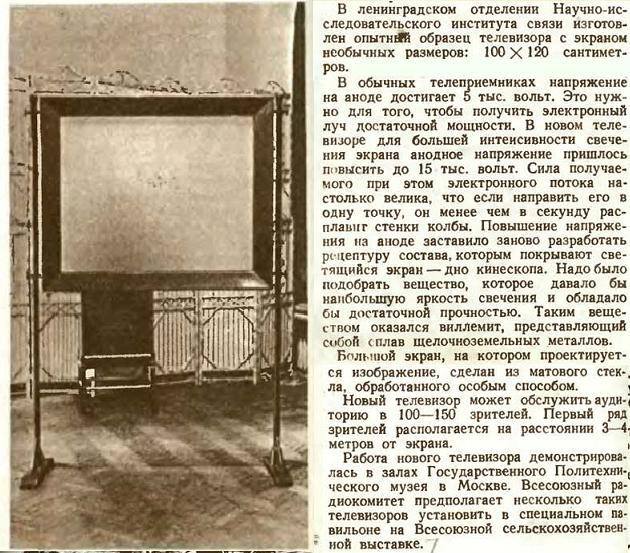
This, unfortunately, is everything, but abroad - the projection technology has continued and continues to evolve.
In February 1957, the Council of Ministers issued a decree. on color television with the instruction to start next year, 1958, an experimental broadcasting on a simultaneous (compatible) system. By November 1959, OSTT-2 was mounted on Shabolovka, which in January 1960 began regular NTSC broadcasting. Televisions produced two plants: in Leningrad, the plant them. Kozitsky (new "Raduga"), and the Moscow Radio Plant - "Temp-22". A total of about 4,000 pieces were produced, but they did not go on sale.
As a result, in March 1965, an agreement was signed between the USSR and France on cooperation in the field of color television and a transition was made to the Soviet-French system SÉCAM. The first broadcast color TV show in the USSR took place on November 7, 1967. The first color TVs were also French - several hundred KFT TV sets were purchased.
Rubin-401 is the first serial color TV in the USSR (1967).
"Rubin-714" - the first in the USSR serial color TV with a 61 cm screen diagonally (1976) - one of the most popular Soviet televisions.
In the 1970s and 1980s, there was a gradual replacement of the park of black-and-white TVs with color domestic production. The park of color televisions was difficult to form, although they were sold for a long time even below cost. In the early years of color broadcasting, there was even a real sales crisis: the population almost stopped buying black and white televisions on the occasion of the “advent of color television”, but had not yet decided to buy quite expensive color ones, without being sure of their quality and reliability (and the amount of color TV programs grew then very slowly).
In the late 1980s, in the USSR, the population already had more than 50 million color television sets.
And how can you not remember the history of the creation of the Lviv plant "Electron".
In 1946, Lawrence Beria struck at the Politburo with the idea of denationalizing the Western regions of the Union by transferring to it the objects of the defense industry from the central regions . Clause 32 of the five-year plan law 1946-1950 provided for "the transformation of Lviv into a major industrial center of the republic" . Of course, the local "Bandera" to work in defense enterprises were not allowed. Plants from central and northeastern regions of Russia were transferred to Lviv together with the service personnel. The experience of creating plants of "telegraph and telephone equipment", "Lvivpribor" and "LAZ" and showed the effectiveness of this method. Therefore, when in 1956 they began to decide where to create a new television equipment plant, they decided that there was no better place than Lviv. The director of the plant was appointed an experienced Stalinist leaver, Stepan Ostapovich Petrovsky. He did not have a higher education, but he knew people very well, knew how to lead them, and intuitively saw ways to solve strategic tasks. In general, was a man in his place. He chose the plant of measuring devices as the base for "Electron", which from October 4, 1957 began to be called the "television" plant. Whole subunits and workers were transferred to Lviv from leading television plants - the Aleksandrovsky Vladimir region, the Leningrad name Kozitsky, the Moscow Rubin. True, as in these factories, TV production was only 30%. The main products were electronic stuffing for fighters and bombers, long-distance tracking systems and other defense equipment. But at the same time, in 1957 more than a million TV sets were already produced in the USSR! In 1958, the first Lviv TV "Lviv" was released (based on the Alexander TV, Priziv). With the first release of production and housing began. Factory workers stood in a queue for an apartment for no more than 3-5 years, while native Lviv residents had been expecting improvement in living conditions for almost their entire life. At the same time, new, for some reason, multi-storey production buildings were being built, although the planning was technologically optimal. In 1960, the Central Committee issued a decree “On the Development of Soviet Television”, in which television was proclaimed “an important means of communist education of the masses in the spirit of Marxist-Leninist ideology and morality, and irreconcilability towards bourgeois ideology” In 1961, the black and white Ogonyka production of the best TV set of the Soviet Union began in the huge new Electron case.
When in 1962, on the instructions of the Central Committee of the CPSU, they created a Sunday entertainment program, which is being filmed in a cafe with the TV “Spark”, it was first called “Spark”, and then “Blue Spark”. Khrushchev times made changes in the personnel issue. Lviv stopped importing labor from the central regions of Russia. With the introduction of a general passport to the city, the population of the surrounding villages rushed. Yesterday's collective farmers had to be taught. The engineering staff trained the departments of the Polytechnic Institute, and a huge technical college of radioelectronic industry was created to train qualified assemblers. Unfortunately, with the collapse of the “Electron”, its specialists turned out to be useless to no one, and the technical school, turning into an institute of a different profile, passed to the Ministry of Education. That's just his students were able to occupy only two floors of a colossal dormitory. All other premises were leased to different firms. While low-income students still have nowhere to live, the director of the technical school built a chic cottage on the closed territory of the defense workshops "Kitvy".
Despite the fact that TV is not a luxury item, you need to remember when and by whom it was invented. We owe the appearance of a modern device to scientists all over the world. Thanks to them, this device has become a familiar thing in every home.
The creation of the TV was preceded by the following important discoveries:
- The physicist Huygens discovered the theory of light waves.
- Scientist Maxwell proved the presence of electromagnetic waves.
- Experiments with television systems started when scientist Smith discovered the possibility of changing electrical resistance.
- Alexander Stoletov demonstrated the effect of light on electricity. He developed the "electric eye" - a kind of current photovoltaic cells.
Together with these studies, scientists around the world studied the effect of light on the chemical composition of elements and discovered a photoelectric effect. People have learned that you can see the image with the help of electromagnetic waves, as well as the fact that this picture is transmitted. By that time, radio had already been invented.
Speaking about who invented the first television, one cannot name just one last name, because many people participated in the development and evolution of television. The history of receivers that transmit sound and image begins with the creation of a Nipkov disc, scanning the image line by line. Came up with his technician from Germany, Paul Nipkov.
Karl Brown developed the very first kinescope and called it "Brown's Tube". However, this invention was patented and used to transfer the picture immediately. Several years passed until the audience saw a television set, the height and width of the screen were 3 cm, and the frame rate was ten pieces per second.
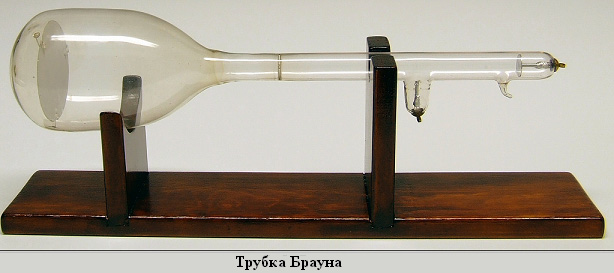
British engineer John Lougie Baird invented a mechanical receiver that works without sound. Although the picture was quite clear. Later, the scientists created the company Baird, which for a long time produced TVs on the market in the absence of competition.

Who is considered the creator of the TV
The first TV was created thanks to Boris Rozing. With the help of an electron beam tube, he received a tele-picture of points and figures. It was a big step forward, which allowed the first electronic television receiver to appear. The sweep of the beam in the tube took place with the help of magnetic fields, the brightness power was controlled by a capacitor.
The case of the physicist was continued by his student Vladimir Zvorykin, who patented television invented by electronic technology in 1932. It is believed that he created the first TV.
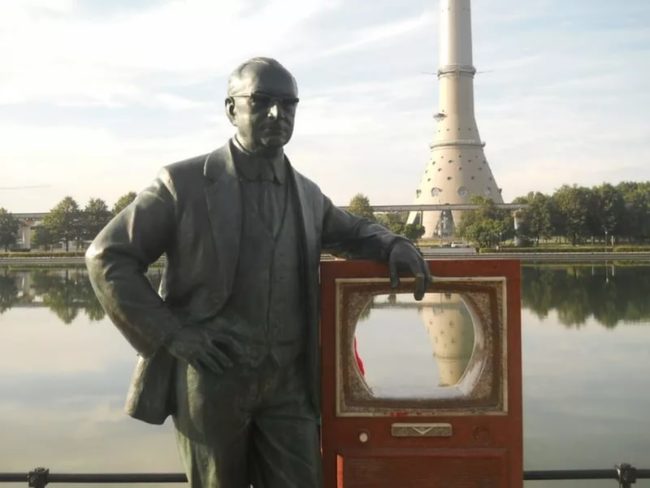
The famous engineer was born in the Vladimir province. He studied in Russia, but subsequently emigrated to the United States. Zworykin opened the first electronic television station in the capital by signing a contract with RCA. He owns more than a hundred patents for various inventions, the scientist has a huge number of awards. He died at the end of the 20th century, after his death the documentary film “Zvorykin-Muromets” was shot.
Today in Moscow and Murom you can see memorial memorials in honor of the “father of television”. One of the streets in the city of Gusev and the award for achievement in the television field is named after him.
The appearance of the TV in the USSR
The earliest television broadcasting experience in the Soviet Union took place in April 1931. Initially, the views were held collectively in certain places, in each family television receivers began to appear later. The first TV set created on the Nipkov disc was launched by the Leningrad plant Comintern. The device looked like a prefix with a 4 by 3 cm screen and connected to a radio. The inventors of the Soviet Union began to assemble mechanical models of devices on their own, and the first television sets appeared in the houses. Instructions for assembling such TVs in the USSR were published in the Radiofront magazine.
At the beginning of the 20th century, the first broadcasts of the program with sound appeared. For a long time there was only one channel - First. During the Second World War, the work of the channel was interrupted. After the end of the war, an electronic TV set appeared, the Second Channel broadcast soon began.
Creating a color TV
Not everyone knows when the first color TVs appeared, which have long been in every family. Attempts to create a device with a color screen were made in the days of mechanical broadcast devices. Hovhannes Adamyan presented his research in this field for the first time; he patented a two-color signaling device at the beginning of the 20th century.
If we talk about when the color receiver was invented, then the work of John Lougie Byrd should be noted. In 1928 he assembled a receiver, which in turn transmitted images using a three-color light filter. He is considered the creator of color TV.
The world's first television with a full-color screen invented by Americans in the middle of the 20th century. These devices were manufactured by RCA. Already then they could be freely bought on credit. In the Soviet Union, color television was introduced somewhat later, despite the fact that the development of the device began under Zvorykin. It was “Ruby”, which later became a massive TV.
There is no definite answer to the question “who created the television receiver”. However, based on the prevailing views and available facts, the founder of television is considered to be Vladimir Zvorykin. If we talk about the year when the television was invented, then it is considered to be 1923, when Zvorykin filed an application for a television patent.
Today, TV is a part of our life and the norm; new models of devices are being created that are completely different from the first TVs. Their screens are measured in tens of centimeters. The quality of broadcasting has greatly increased and has become digital. Over the past 20 years, television has stepped far forward, and, for sure, will continue to develop. And for all this you need to say thanks to the one who came up with television.
The first experience of a television program was conducted on May 22, 1911 by Boris Lvovich Rosing, and he managed to transfer the picture to the screen of the invented kinescope. But another 17 years passed before the student of Rosing, a talented Russian engineer Vladimir Zworykin, who was forced to go abroad, created the first mechanical scan TV in the US. The production of cathode-ray television sets was launched in the USA only in 1939.
The Soviet Union in the field of television technology did not lag behind other countries. Already in 1932, the industrial production of the B-2 TV, developed by engineer A.Ya. Breitbart. By modern standards, it was a rather primitive opto-mechanical device with a screen size of 3 to 4 cm. The first Soviet television was not even an independent device, but was a prefix to the radio.
Production of the first electronic televisions in the USSR was launched in 1938 - that is, a year earlier than in the USA. The TV was called “ATP-1”; nine electronic tubes were used in the design. At the time, its design was very successful, the image quality was very high. The designers have developed a more advanced model, but its release was prevented by the war.
After the war, a new model of the KVN-49 TV was developed and launched in 1949; it is this that can be considered the first mass Soviet television. The screen size was 10.5 by 14 cm, the TV could take three channels. To increase the size of the image, a special hollow plastic lens filled with water was used. It was placed in front of the screen, it could be moved back and forth, achieving a high-quality image. In total, about two million of such televisions were produced, for many Soviet people it was KVN-49 that became the first television receiver in their life.
Since the 50s in the USSR produced a lot of TV models, but they were all black and white. Soviet designers were actively working on the transition to color television, and in 1967 the first domestic color TVs, Record-101, Raduga-403 and Rubin-401, went on sale. A little later, they began to produce large quantities of 700-series televisions, which became very common. The first models had a screen with a diagonal of 59 cm, a little later the screen size increased to 61 cm.
It was these color televisions, along with the black and white models that continued to be produced, that made up the main park of television equipment of the 70s.
From ancient times magical objects were mentioned in tales of various nations of the world, with the help of which one could not only see what was happening somewhere far away, but also convey one's image there. But it was only in the 20th century that a device appeared, called “TV” (that is, “far-seeing”), which truly turned the tale into reality. How was it invented?
Instruction
In order to be able to transmit an image over a long distance, it is necessary to convert the optical signal into an electrical one. This transformation is based on a phenomenon called a photoelectric effect. This phenomenon was discovered (although, having failed to explain it, since then the concept of “electron” did not exist) by the German physicist Hertz at the end of the 19th century.
The first films in the history of cinema
The world's first film, Scenes in the Roundhay Garden, was filmed in England in 1888, directed by Frenchman Louis Le Prince, and for filming a new technology for recording on a special film made of paper was used. The first film was about 1.66 seconds.
The first film, which received fame, was the “Arrival of the train at La Ciotat” by the Lumiere brothers. The documentary short film was shot in 1895. According to the surviving data, the effect of watching the first film in the world was really stunning. The spectators jumped from their seats, not expecting to see on the screen an image of a moving train and people on the platforms. It is noteworthy that the train is moving in perspective, and when shooting people already used a common, large and medium plan.
Shortly after the appearance of the movie "Arrival of the train at the station of La Ciotat," other directors hurried to make similar films at train stations around the world.
The first trends, indicating the imminent emergence of feature films, appear in another picture of the Lumiere brothers, "The Watered Sprinkler." The short duration of the first films was due to the technical imperfection of the equipment for creating cinema, but by the beginning of the 1900s the length of the films had gradually increased to 20 minutes.
The first movie with sound was “Singer
May 10, 1932 in Leningrad at the plant "Comintern" was produced the first batch of Soviet televisions - 20 test copies of the device with the name B-2.
This gave rise to the domestic production of television receivers, which had periods of rise and fall, success and failure. And today we will tell about the 10 most famous, legendary TVs of the Soviet era, some of which are still working for their intended purpose ...
Set-top box B-2
1. TV B-2 was released before the regular television broadcasting began in the Soviet Union. It was developed in 1931 by Anton Breitbart, the test batch was released in 1932, mass production began in 1933 and lasted until 1936. 
2. B-2 had a screen of 16 by 12 millimeters with a scan of 30 lines and a frequency of 12.5 frames per second. It is now such dimensions and figures seem ridiculous, but then the device was considered incredibly modern from a technological point of view.
However, the B-2 was not a television receiver, like the televisions we were used to, but only a prefix that needed to be connected to a mid-wave radio.
KVN-49 
3. In the late 1930s - early 1940s, several models of electronic televisions were produced in the Soviet Union, partly under an American license, partly developed by themselves, but they never became a mass product - the Great Patriotic War prevented. And the first truly "popular" apparatus was the KVN-49. 
4. The television that became legendary was developed at the Leningrad Scientific-Research Institute of Television by engineers Koenigson, Warsaw and Nikolayevsky, after whom it received its name. This device was one of the first in the world, designed for the 625/50 decomposition standard.
KVN-49 was produced in various modifications until 1967, but it is still known to the general public due to its unusual appearance (mounted lens with water or glycerin to enlarge the image) and the popular comic game, named after him.
Rubin-102 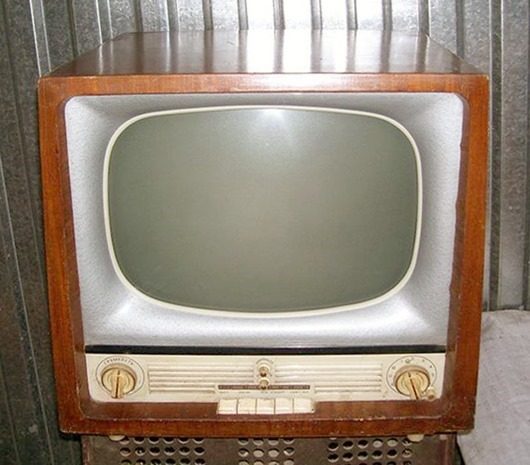
5. In 1957 began the era of Soviet televisions under the legendary brand Rubin. This year the mass production of the television receiver Rubin-102 started, which lasted for 10 years. During this time, more than 1 million 328 thousand copies were created. 
6. Rubin-102 could receive 12 TV channels (it was really much less) and switch to radio waves. It also had sockets for a tape recorder and a sound pickup.
Rubin 714 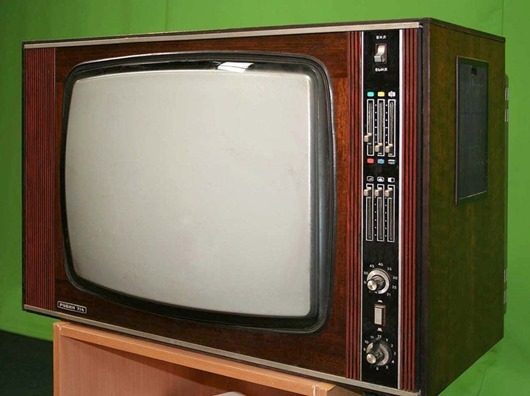
7. But still, the name “Ruby” is associated, first of all, with the television receiver Rubin-714. It was not the first Soviet color television, but became one of the most popular in the country - in nine years in 1976-1985, 1,443,000 copies were released, of which 172,000 were exported. 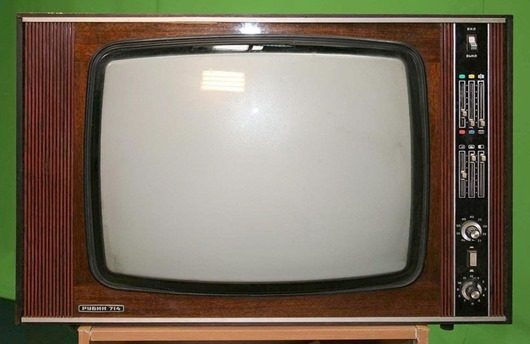
8.
Dawn-307 
9. But even these huge numbers fade away when compared with the number of Dawn-307 TVs produced. Indeed, in the entire history of this model and very close to it 307-1 8 (!) Million pieces were produced. 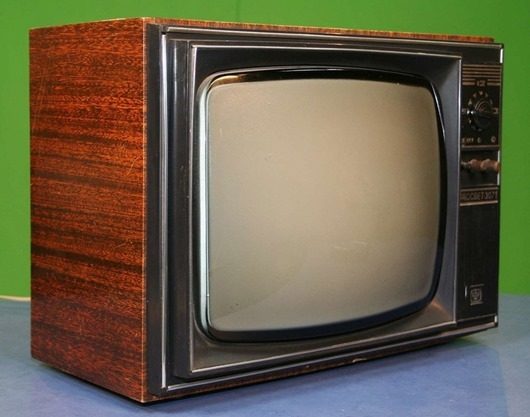
10. This black and white television receiver began to be produced in 1975, when color television sets appeared, and, nevertheless, it still gained tremendous all-Union popularity. This happened, first of all, due to the high reliability of the device, as well as its low price, compared to color competitors.
Record B-312 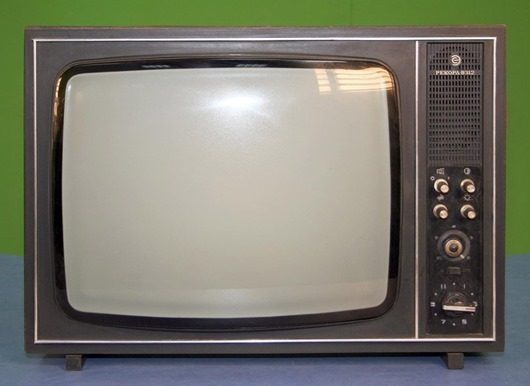
11. Another super-popular black and white TV, which was mass produced and sold in an era when color receivers were already fully produced. The B-312 record could be bought in two design options: woodwork with a glossy surface and coated with texture paper. 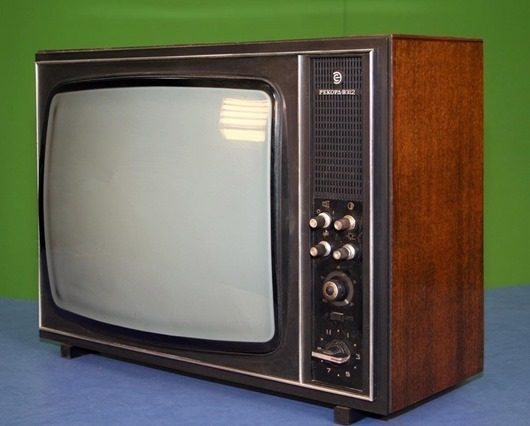
12. TV Record B-312 was produced from 1975 to the mid-eighties. He remembered to people that it was very difficult to turn the toggle switch to switch channels, especially if the handle was lost, and often had to use pliers or pliers for this.
Horizon ts-355 
13. And Horizon C-355, produced at Minsk Radio Factory since 1986, was considered the ultimate dream of a Soviet person. This television set was an incredibly scarce device - people were willing to overpay significant sums for the right to buy such a device for themselves home. 
14. The fact is that, unlike other Soviet televisions, the Horizon C-355 was equipped with a Toshiba Japanese kinescope with a beam angle of 90 degrees. And because the TV did not require additional adjustment of the image, and was also much more reliable than the receivers with domestic components.
Spring-346 
15. One of the best Ukrainian factories that produced TV sets was the Spring Concert from Dnepropetrovsk. The first television set there was released in 1960, but the heyday of the enterprise occurred in the seventies and eighties. The most famous and popular product of this manufacturer was the TV Spring-346 (aka - Yantar-346). 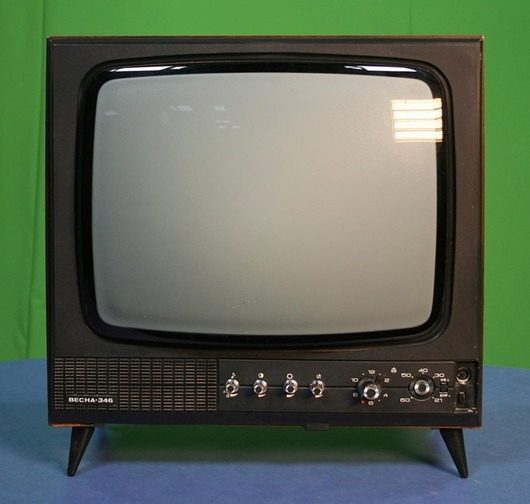
16. The Spring-346 TV set was produced since 1983 and became the last successful model of the Dnepropetrovsk plant - the next ones did not gain much popularity, and in the nineties the enterprise, like many others, could not stand the competition from foreign technology and suspended production.
Electron C-382 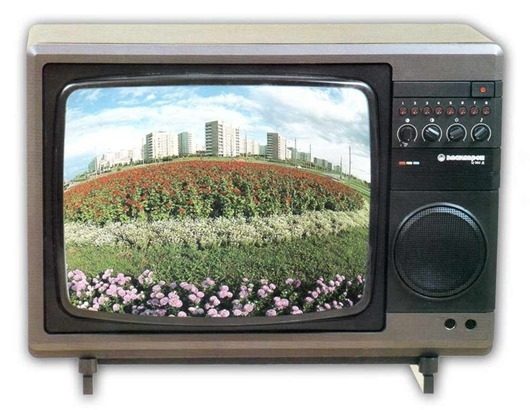
17. Another legendary TV manufacturer in the Ukrainian SSR was the Lvov Electron plant. In the eighties, he released several color TV models that were popular all over the Soviet Union, the most massive of which is considered the Electron C-382. 
18. Electron C-382 stood out among other Soviet televisions of that era with good image quality, high reliability, stylish design and low electricity consumption. In particular, due to the success of this model, every fourth TV in the USSR in the eighties was produced by the concert "Electron".
The plant "Electron" and now produces TVs under its own brand. True, their popularity is much less than in Soviet times.
Age mate 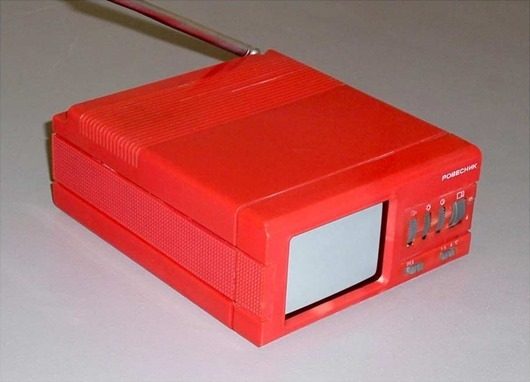
19. The same age - the smallest TV produced in the Soviet Union. This is a portable portable television receiver, which could be purchased assembled, or as a designer, in order to fold the device itself according to the instructions. The last option cost 20 rubles cheaper - 100 rubles. 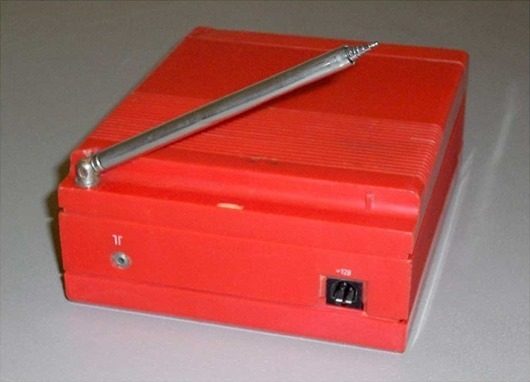
20. TV The same age had a screen with a diagonal of 8 centimeters and weighed only 1.4 kilograms without a battery.
